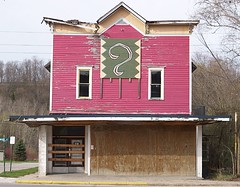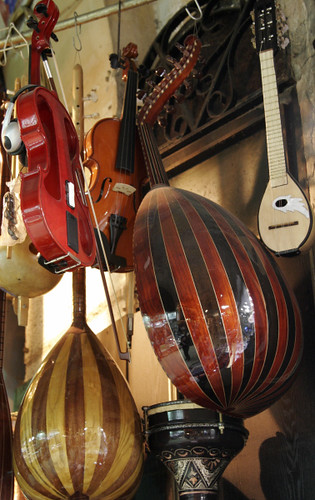Question Mark Sign On Hobson's Old Building, Corner Of Henry & Main (Honor, MI) originally uploaded by takomabibelot.

I've been noodling this one for quite a while. I started to verbalize it after
posting about my 1st Blog Bday back in June, and
my July Blogtippings post...
Two recent posts -
What Luxury Marketing Can Teach Us and
In Search Of An Experience - have propeled the thought process forward.
In fact, I have a challenge in mind. Will you take part?
This from
my July Blogtippings post:
Imagine transforming a lousy experience - in flooring, for example - into a positive simply by figuring out How to be Different - as Ryan Karpeles describes. Or, consider truly looking at the world from your customer's perspective as Becky Carrol illustrates via Customer Lenses... to better appreciate where our customers are coming from and going to - literally and figuratively - to then craft a better marketing experience with them. I wondered then - as I do now -
what a really fun flooring retail experience would look like....
I believe that consumers are truly
 In Search Of An Experience
In Search Of An Experience for every category out there. Look at the transformations that surround us....
Apple vs. electronics.
Starbucks vs. the corner coffee shop.
Barnes & Noble vs. musty/dusty bookstores.
Flooring - in my mind - represents untold opportunity for reinvention.
Melodies In Marketing's Mario Vellandi comments that "
experience design is what it all comes down to nowadays.... Diverse affordable merchandise is available practically everywhere. What's the differentiator if people could get cheaper goods at any discounter? An emotional experience across multiple interaction points is what builds loyalty, and makes the shopping trip memorable and WOM-worthy."Yes. Absolutely!
Peter Kim has had recent flooring experiences, and they've been lousy. He says: "
I'm building a house and there wasn't much of a flooring experience of which to speak. I imagine part of this comes from the fact that the particular store I'm working with must have a heavy commercial business, so focusing on the individual consumer isn't a priority. However, I probably would've bought much more expensive tile and carpet if it had just been presented differently, rather than assorted manufacturer POP displays stuck into free space around the store. Unfortunately for flooring, my understanding is that it typically happens last in the decision-making process when most people have already spent a ton of money. In any case, using personas and tailoring an experience for your most important customers would still go a long way... "
Pete highlights a critical point that works against flooring: decisions tend to be made late in the design process, and thus get short shrift. Subject for another discussion.
Using personas and tailoring the experience - as Becky also suggests, would definitely help. But what about product presentation? How might that be improved?
If you remember from
What Luxury Marketing Can Teach Us, Chris Ramey made specific suggestions for product presentation: sorting by color, editing out anything that isn't consistent with store message and positioning, even eliminating wing racks... Not doing so leads to missed opportunities to trade customers up on their product choices - as Pete describes.
How might displays do a better job telling the product story? Flooring can absolutely transform the vibe of our homes - our most precious and individualized investment - by adding luxurious texture and cushiony warmth with tantalizing color underfoot, or creating a polished, glistening opulent formal entertaining floor surface, or a practical, hearty, Tuscan-like kitchen backdrop.
Given the rich potential of the category, how might it be better displayed?
Mario Vellandi offers an interesting analysis of
Merchandising Innovation: Soup. If soup can be improved, can't carpet?

Check out the
Advantage Line and Foster's Wine Bar. It was originally featured in the April 2007 issue of
Marketing At Retail. This display system represents true innovation in wine display; it significantly improves the shopping experience, making it easier for shoppers to find the right wine; and educates. The end result: it grows total wine sales and grows the value of the category. [
Independent Retailer has a better visual here]
My dream flooring store would include all of the elements relevant to the creation of a perfect home interior... paint, wallpaper, lighting fixtures, ... It probably wouldn't be called a flooring store since it's more about creating that perfect home space. Perhaps it's a concept store [think of all of the marvelous vignettes that
IKEA creates in-store, or the wealth of ideas that a
Pottery Barn catalog offers].
Within, I'd want to linger, take my time, relax and reflect and a coffee bar would really help nurture the right vibe. Music, too. It should definitely represent an opportunity for
feasting the senses. Organization by color seems like a no-brainer. That's how I shop for carpet.
But, I get stuck on how best to display product samples. Retail salespeople tell me that big carpet samples sell product because consumers can better visualize the product. Ironically, product displays are trending smaller. The end result is a large swatch with microscopic samples detailing color options. [Note: the two photos above capture two displays from our last
Surfaces trade show booth.]
So, tell me. How would you display flooring products? How best to let them tell their story? How to showcase product so it sings to us as we select the most beautiful product possible to enhance our home living environment?
Naturally, I'd like to hear from as many of you as care to participate in this fundamental retail challenge. I particularly welcome additional thoughts from
Mario Vellandi,
Peter Kim,
Becky Carroll,
David Armano,
Ryan Karpeles,
Shannon Bilby and
David Polinchock.
The challenge:
1. Share your vision and perspective on how to display carpet so it enchants consumers.
2. Refer back to this post.
3. Encourage others with a passion for design, user experience, or a firm desire to banish sad consumer experiences to participate.
My promise:
I will recap all of the responses in a separate post. I also expect to share your thoughts at every opportunity with the flooring industry - in presentations, articles and blogposts at
Talk Floor Blogs.
Thank you.
Technorati Tags: carpet flooring flooring displays carpet displays retail experience Del.icio.us Tags: carpet flooring flooring displays carpet displays retail experience





.JPG)


.jpg)








